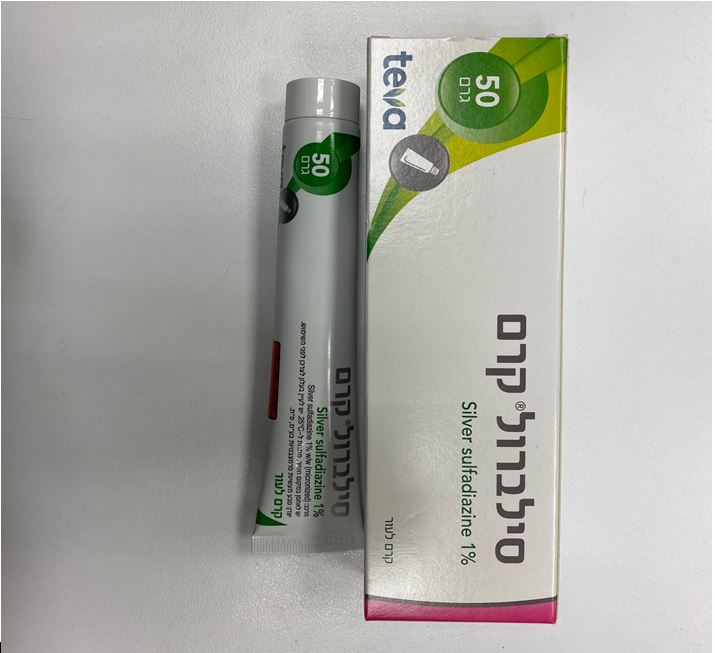Quest for the right Drug

סלברול קרם SILVEROL CREAM (SULPHADIAZINE SILVER)
תרופה במרשם
תרופה בסל
נרקוטיקה
ציטוטוקסיקה
צורת מתן:
עורי : DERMAL
צורת מינון:
קרם : CREAM
עלון לרופא
מינוניםPosology התוויות
Indications תופעות לוואי
Adverse reactions התוויות נגד
Contraindications אינטראקציות
Interactions מינון יתר
Overdose הריון/הנקה
Pregnancy & Lactation אוכלוסיות מיוחדות
Special populations תכונות פרמקולוגיות
Pharmacological properties מידע רוקחי
Pharmaceutical particulars אזהרת שימוש
Special Warning עלון לרופא
Physicians Leaflet
Posology : מינונים
4.2 Posology and method of administration Silverol should be applied in a layer approximately 3-5 mm thick with a sterile, gloved hand or spatula, to completely cover the burn area. Ordinarily, blisters are not opened, but loose tissue is generally removed prior to application. After application of Silverol, the wound should either be left exposed or covered with a fine mesh gauze and an elastic mesh bandage. The exposure method is preferable in some patients (such as children) and for certain parts of the body (face, genitalia, etc.). When the wound is exposed, Silverol should be reapplied at about 12-hour intervals, or more frequently if the medication is rubbed off on the bedding. When dressings are used, they should be changed daily or on alternate days. Use of dressings serves to press the medication firmly against the wound, helps keep the area moist, reduces evaporative water loss and prevents drying/caking of the medication. Silverol dressings can usually be left in place for about 48 hours during the first 2 weeks post burn. Subsequently, necrotic tissue undergoes proteolytic decomposition, producing considerable exudate which dilutes the drug and necessitates more frequent dressing changes. When feasible, patients should be bathed daily as an aid in debridement. A whirlpool bath is particularly helpful, but patients may be bathed in bed or in a shower. With Silverol treatment, there will generally an absence of infection, and examination of the wound will reveal soft pliable eschars. These will separate gradually, leaving a clear granulating surface. In partial-thickness burns, the generating epithelium often appears in about 2 weeks, and burns initially classified as full-thickness injuries often heal within 5 weeks without grafting. In leg ulcers, Silverol should be applied followed by an absorbent gauze dressing and a support bandage, e.g. 10 cm elastic bandage. Care should be taken not to spread Silverol on to non-ulcerated skin, and it should not be used on every wet ulcer. The dressing should be changed at least 3 times a week, and desloughing and cleansing should be carried out at the same time. Any Silverol remaining at the end of treatment should be discarded. Treatment with Silverol should be continued until satisfactory healing has occurred, or until the burn site is ready for grafting. The drug should not be withdrawn from the therapeutic regimen while the possibility of infection remains, unless a significant side effect occurs.

שימוש לפי פנקס קופ''ח כללית 1994
Prevention and treatment of wound sepsis in second and third degree burns
תאריך הכללה מקורי בסל
01/01/1995
הגבלות
תרופה שאושרה לשימוש כללי בקופ'ח
מידע נוסף
עלון מידע לצרכן
07.08.22 - עלון לצרכן אנגלית 07.08.22 - עלון לצרכן עברית 07.08.22 - עלון לצרכן ערבית 02.11.23 - עלון לצרכן עברית 22.12.23 - עלון לצרכן אנגלית 22.12.23 - עלון לצרכן עברית 22.12.23 - עלון לצרכן ערבית 14.06.20 - החמרה לעלון 28.02.22 - החמרה לעלון 30.05.22 - החמרה לעלון 03.11.23 - החמרה לעלוןלתרופה במאגר משרד הבריאות
סלברול קרם